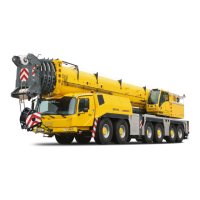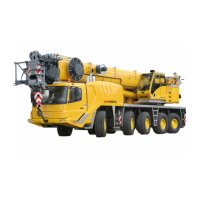Grove Published 04-04-2017, Control # 446-09 3-31
RT770E OPERATOR MANUAL OPERATING CONTROLS AND PROCEDURES
• Remove all cribbing or other non-standard accessories
from the crane.
• Avoid holes, rocks, extremely soft surfaces and any
other obstacles that might subject the crane to undue
stresses and possible overturn.
• Ensure adequate clearance to any overhead
obstructions that the crane may be required to travel
beneath.
• Ensure that all personnel involved in the operation and
those working around the crane are aware of any
hazards that may be encountered and are trained about
how to avoid the hazards.
Traveling with Boom Extension and/or Inserts
Erected
10.1m (33ft)/17.1m (56ft) Extension
Follow the steps below when traveling with the extension
erected:
• Position the 10.1 m (33 ft) or 17.1 m (56 ft) boom
extension at minimum offset. If traveling with just the
10.1 m (33 ft) extension, stow the stinger section on the
boom base section, not on the extension base section.
• Travel only on a firm, level surface.
• Fully retract the main boom.
• Limit main boom angle to a minimum of 0° and a
maximum of 40°.
• Do not exceed a speed of 4 km/h (2.5 mph).
• Ensure main counterweight is installed.
• Position the boom over the front of the crane.
• Engage the swing brake and turntable lock pin.
• Remove hook block from main boom nose.
• Headache ball may be reeved over boom extension,
hanging 0.9 m (3 ft) below sheave.
10.1m (33ft)/17.1m (56ft) Extension Plus 6.1m
(20 ft) Insert
Follow the steps below when traveling with the extension
and insert erected:
• Position the 10.1 m (33 ft) or 17.1 m (56 ft) boom
extension plus 6.1 m (20 ft) insert at minimum offset. If
traveling with just the 10.1 m (33 ft) extension and insert,
stow the stinger section on the boom base section, not
on the extension base section.
• Travel only on a firm, level surface.
• Fully retract the main boom.
• Limit main boom angle to a minimum of 0° and a
maximum of 20°.
• Do not exceed a speed of 4 km/h (2.5 mph).
• Ensure main counterweight is installed.
• Position the boom over the front of the crane.
• Engage the swing brake and turntable lock pin.
• Remove hook block from main boom nose.
• Headache ball may be reeved over boom extension,
hanging 0.9 m (3 ft) below sheave.
10.1 m (33 ft) Extension Plus 12.2 m (40 ft) Insert
Follow the steps below when traveling with the extension
and insert erected:
• Position the 10.1 m (33 ft) boom extension plus 12.2 m
(40 ft) insert at the minimum offset. Stow the stinger
section on the boom base section, not on the extension
base section.
• Travel only on a firm, level surface.
• Fully retract the main boom.
• Limit main boom angle to a minimum of 0° and a
maximum of 20°.
• Do not exceed a speed of 4 km/h (2.5 mph).
• Ensure main counterweight is installed.
• Position the boom over the front of the crane.
• Engage the swing brake and turntable lock pin.
• Remove hookblock from main boom nose.
• Headache ball may be reeved over boom extension,
hanging 0.9 m (3 ft) below sheave.
Extended Travel
Depending upon the tire manufacturer, the higher inflation
pressures normally specified for lifting on rubber are not
recommended for site to site transfer over extended
distances. The higher static/creep 8 km/h (5 mph) inflation
pressures may remain in the tire while operating the crane
on site within a distance of less than 6.4 km (4 mi).
CAUTION
Tire Damage!
For extended travel, check the cold tire pressure prior to
start. (Refer to tire inflation chart in Load Chart Book.)
After every one hour of travel time, regardless of ambient
temperature, stop and allow the tires to cool off for at least
30 minutes. At the destination, the tires must be allowed
to cool to ambient temperature before crane lifting on
rubber.

